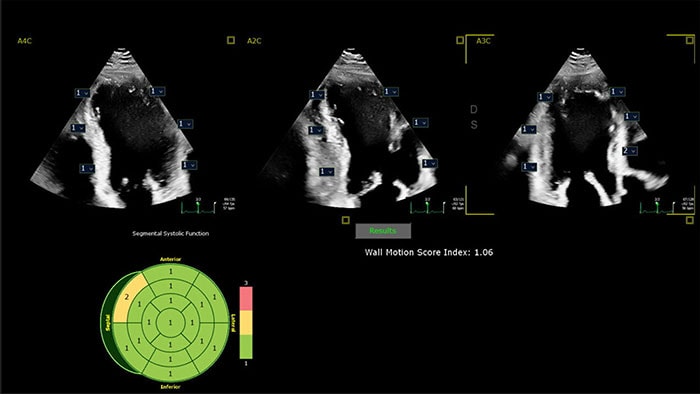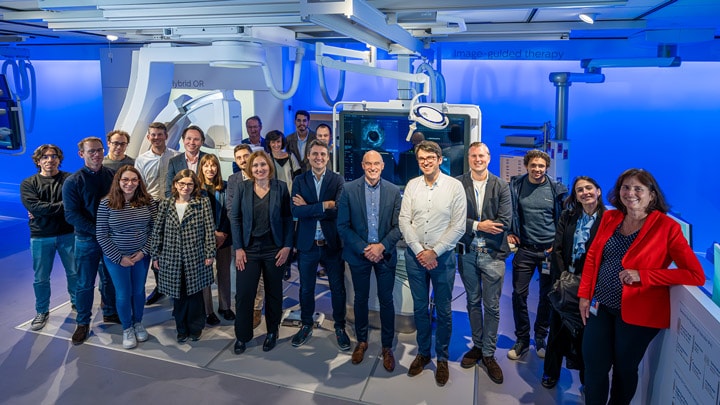Also read the press release: Philips and the Spanish National Center for Cardiovascular Research (CNIC) collaborate on a new ultra-fast cardiac MRI protocol for research purposes with the aim of benefitting clinical practice in the future
During an MR cardiac examination, patients are required to lie still inside the bore of the scanner for about one hour. The reason for this is that in order to measure diagnostic markers such as left ventricular ejection fraction (LVEF) and right ventricular ejection fraction (RVEF), and assess the extent of damaged heart muscle, multiple image acquisitions, each comprising multiple (13 - 15) 2D image slices in complex 3D orientations, need to be captured and reconstructed.
The newly researched protocol [1], developed as part of a wider collaboration between Philips and CNIC, involves acquisition of a full thorax non-angulated 3D volume, where the static information and beating heart regions are acquired with different sensitivity encoding (SENSE) acceleration factors interleaved during a single breath-hold. SENSE acceleration is a technique applicable to phased-array MRI scanners that significantly reduces scan time.
During generation of the images, this SENSE factor interleaving allows the entire thoracic volume to be calibrated and divided into static (non-heart) and dynamic (heart) regions. The static regions are reconstructed once and then subtracted from subsequent image data sets - hence the name of the technique ‘Enhanced SENSE by Static Outer-volume Subtraction’ (ESSOS) allowing the smaller volume dynamic regions to be reconstructed using higher SENSE factors with minimal noise amplification. These volume-specific SENSE factors allow high quality imaging of the heart in a much shorter time. Once the dynamic information is reconstructed, the static (outer volume) images are added to the dynamic images to generate a full 3D cardiac cine with isotropic resolution, allowing review from different views with good image resolution.
To fully assess the extent of damaged heart tissue, the first scan is followed by another single-breath-hold 3D scan to image the uptake of a gadolinium contrast agent injected into the patient before the procedure a so-called late gadolinium enhancement (LGE) scan.
‘Door to door’, the entire procedure could take around a quarter to a fifth of the time currently required.
The results of a clinical trial in which more than 100 patients with various cardiac pathologies were examined using both the conventional and the new MR protocol, with the resulting images being evaluated by expert radiologists, demonstrated excellent agreement between LVEF and RVEF measurements made using each technique, as well as excellent agreement in the assessment of scar extension from LGE images [2].
[1] Device for research applications only. Not for clinical use.
[2] Gómez-Talavera S, Fernandez-Jimenez R, Fuster V, Nothnagel ND, Kouwenhoven M, Clemence M, García-Lunar I, Gómez-Rubín MC, Navarro F, Pérez-Asenjo B, Fernández-Friera L, Calero MJ, Orejas M, Cabrera JA, Desco M, Pizarro G, Ibáñez B, Sánchez-González J. (2021). Clinical Validation of a 3-Dimensional Ultrafast Cardiac Magnetic Resonance Protocol Including Single Breath-Hold 3-Dimensional Sequences. JACC Cardiovasc Imaging, doi: 10.1016/j.jcmg.2021.02.03
About Royal Philips
Royal Philips (NYSE: PHG, AEX: PHIA) is a leading health technology company focused on improving people's health and well-being, and enabling better outcomes across the health continuum – from healthy living and prevention, to diagnosis, treatment and home care. Philips leverages advanced technology and deep clinical and consumer insights to deliver integrated solutions. Headquartered in the Netherlands, the company is a leader in diagnostic imaging, image-guided therapy, patient monitoring and health informatics, as well as in consumer health and home care. Philips generated 2020 sales of EUR 17.3 billion and employs approximately 77,000 employees with sales and services in more than 100 countries. News about Philips can be found at www.philips.com/newscenter.
About CNIC
The National Center for Cardiovascular Research (CNIC), led by Dr. Valentín Fuster, has as its mission to enhance cardiovascular research and its translation to the patient. The center is financed by a pioneering formula of public-private collaboration between the Government of Spain, through the Carlos III Institute of Health, and the Pro CNIC Foundation that brings together 12 of the most important Spanish companies.
Share on social media
Topics
Contacts

Kathy O'Reilly
Philips Global Press Office Tel.: +1 978-221-8919
You are about to visit a Philips global content page
ContinueFatima Lois
Head of Communications of the CNIC
Tel.: +34 6 39 28 24 77













